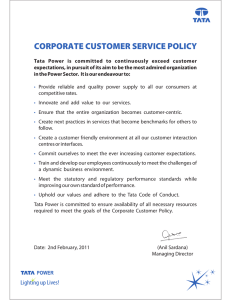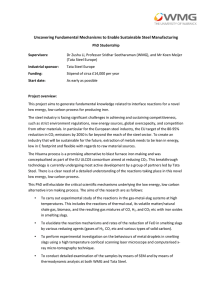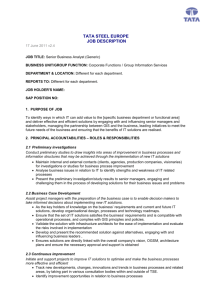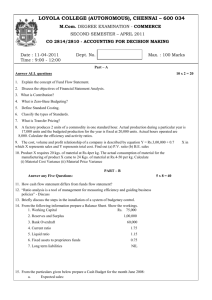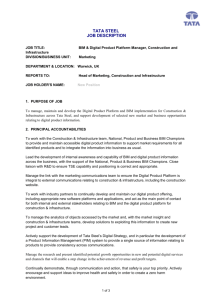ISSN: 2278-6236 (FROM 2008-09 TO 2012-13)
advertisement
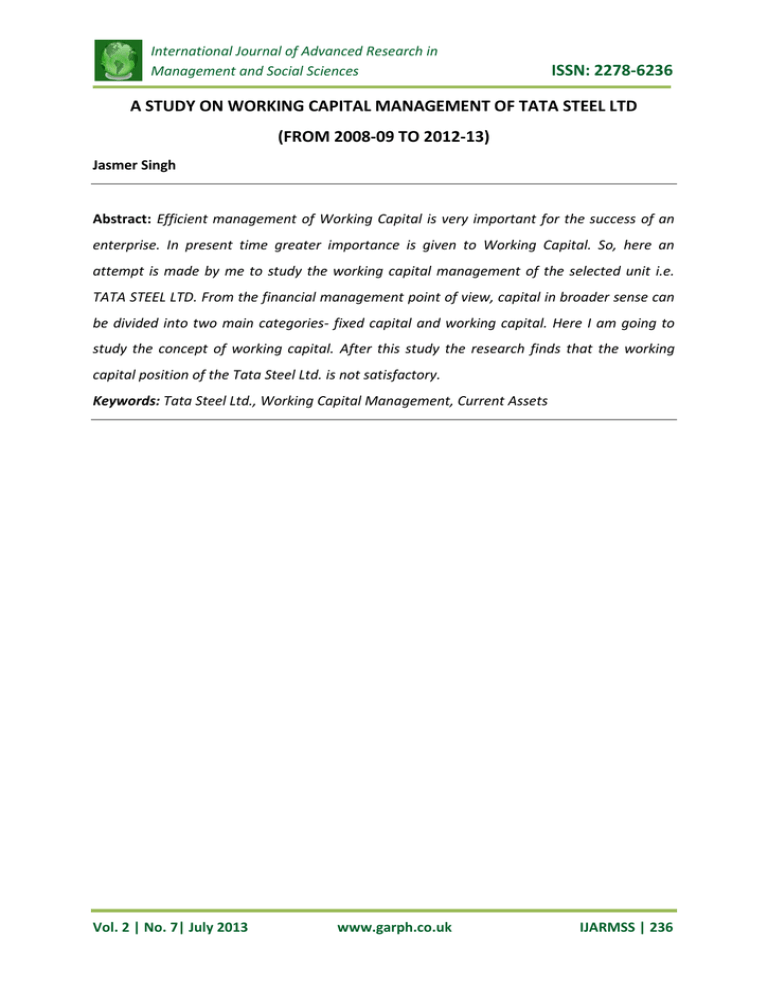
International Journal of Advanced Research in Management and Social Sciences ISSN: 2278-6236 A STUDY ON WORKING CAPITAL MANAGEMENT OF TATA STEEL LTD (FROM 2008-09 TO 2012-13) Jasmer Singh Abstract: Efficient management of Working Capital is very important for the success of an enterprise. In present time greater importance is given to Working Capital. So, here an attempt is made by me to study the working capital management of the selected unit i.e. TATA STEEL LTD. From the financial management point of view, capital in broader sense can be divided into two main categories- fixed capital and working capital. Here I am going to study the concept of working capital. After this study the research finds that the working capital position of the Tata Steel Ltd. is not satisfactory. Keywords: Tata Steel Ltd., Working Capital Management, Current Assets Vol. 2 | No. 7| July 2013 www.garph.co.uk IJARMSS | 236 International Journal of Advanced Research in Management and Social Sciences ISSN: 2278-6236 INTRODUCTION Efficient management of Working Capital is very important for the success of an enterprise. In present time greater importance is given to Working Capital. So, here an attempt is made by me to study the working capital management of the selected unit i.e. TATA STEEL LTD. Concept of Working Capital Analysis From the financial management point of view, capital in broader sense can be divided into two main categories- fixed capital and working capital. Here I am going to study the concept of working capital. The term working capital generally is used in two senses – ‘Gross working capital’ which denotes total current asset and ‘Net working Capital’ which denotes the excess of current assets over current liabilities. Both the concepts have their own significance and relevance. In common parlance, working capital is that part of capital, which is in working or which is used to meet day-to-day expenses. To understand the exact meaning of the term ‘Working Capital’, it will be appropriate to understand its two components – current assets and current liabilities. The current assets are those assets, which can be converted into cash within a short period of time, say not more than one year during the operating cycle of business or without affecting normal business operations. Current liabilities are such liabilities as are to be paid within the normal business cycle a within the course of an accounting year out of current assets. Gross working Capital Concept According to the gross concept, working capital means total of all the current assets of a business. It is also called gross working capital. Gross working Capital = Total Current Assets Net Working Capital Concepts The concepts of Net Working Capital refer to the excess of current assets over current liabilities. It indicates the surplus value of current assets. Since, all the current liabilities are met out of current assets and after meeting the current liabilities what remains in the enterprise is called net working capital. Net working capital will exist only in that case when long-term funds, to some extent, are invested in current assets and comparatively less amount of short term funds are involved in current assets. Vol. 2 | No. 7| July 2013 www.garph.co.uk IJARMSS | 237 International Journal of Advanced Research in Management and Social Sciences ISSN: 2278-6236 Components of Working Capital The working capital consists of two components current assets and current liabilities. Assets of a concern are of two types- Fixed assets and current assets: Fixed assets are to be in business on permanent basis and are not intended for sale whereas the current assets are for conversion into cash at the earliest. Similar is the case with liabilities, which may be longterm liabilities and current liabilities. Long-term liabilities are those maturing over a long period of time usually five or ten years whereas short-term liabilities are those maturing within a short period usually less than a year. OBJECTIVES OF STUDY The present study “A STUDY ON WORKING CAPITAL MANAGEMENT OF TATA STEEL LTD.”, has been designed to achieve the following objectives:(1) To analyses and evaluate the overall working capital management in the selected unit. (2) To analyses and evaluate the trends in Working Capital of the selected unit. SCOPE OF THE STUDY: The present study is confined to the one leading unit in steel industry namely TATA STEEL LTD. The study covers a period of five years from 2008-09 to 2012-13. This period is enough to cover both the short and medium terms fluctuations and to set reliability. DATA COLLECTION:For completion of my study only secondary data has been used. The main sources are annual reports. Besides for framing conceptual framework, various books and published material in standard books and newspapers, Journals and websites has been made use of. LIMITATIONS OF THE STUDY To know the extent to which the study is reliable it is necessary to note the limitations under which the study has been completed. The following important limitations have been noted while conducting the present study:1) The main source of information is annual reports. They represent financial information/position on particular date. What happened between such two dates cannot easily be presumed or predicated. Vol. 2 | No. 7| July 2013 www.garph.co.uk IJARMSS | 238 International Journal of Advanced Research in Management and Social Sciences ISSN: 2278-6236 2) The annual reports mostly contain quantitative and financial information and as regards to qualitative aspect of financial performance, my source was limited due to far away location of head offices of the selected units. 3) The financial performance covering a large period say 20 years or 30 years can give a much clear picture of management practices of financial performance. Our study covering a period of 5 years can touch only a part of the problem. DATA ANALYSIS Level of Current Assets of Tata Steel Ltd. This indicate that how much current assets is held by the company. Higher the current assets better will be the financial posittion of the business. Table & Graph No.1: Level of Current Assets (In Rs. Crores) Year/Company TATA STEEL LTD. 2009 2010 2011 2012 2013 11,591.66 13,425.27 25,569.40 18,483.79 17,860.79 Rs. in Crores Level of Current Assets 30,000.00 25,000.00 20,000.00 15,000.00 10,000.00 5,000.00 0.00 25,569.40 18,483.79 17,860.79 11,591.66 13,425.27 TATA STEEL LTD. 2009 2010 2011 2012 2013 Years (Source: Compile Personally from Annual Reports) INTERPRETATION From the above table and graph it is clear that the level of current assets in Tata Steel Ltd. Is Rs. 11,591.66 Crores in the year 2009. Whereas it become to Rs. 25,569.40 crores in 2011 which is maximum during the period of the study. In the last year of the study is decrease to Rs. 17,860.79 crores. Vol. 2 | No. 7| July 2013 www.garph.co.uk IJARMSS | 239 International Journal of Advanced Research in Management and Social Sciences ISSN: 2278-6236 Level of Current Liabilities of Tata Steel Ltd. This indicate that how much current liabilities is held by the company. Lower current liabilities indicates better financial condition of the business. Table & Graph No.2: Level of Current Liabilities (In Rs. Crores) Year/Company 2009 2010 2011 2012 2013 TATA STEEL LTD. 11,899.95 12,003.02 16,458.91 19,875.88 20,755.74 Level of Current Liabilities Rs. in Crores 25,000.00 19,875.88 20,755.74 20,000.00 15,000.00 16,458.91 11,899.95 12,003.02 10,000.00 TATA STEEL LTD. 5,000.00 0.00 2009 2010 2011 2012 2013 Years (Source: Compile Personally from Annual Reports) INTERPRETATION From the above table and graph it is clear that the level of current Liabilities in Tata Steel Ltd. Is Rs. 11,899.95 Crores in the year 2009. Whereas it become to Rs. 20,755.74 crores in 2013. Current Liabilities show increasing trend during the period of the study. Current Ratio: One of important function of the financial manager is to maintain sufficient liquidity. Current ratio is an important criterion to test the liquidity and also the short term solvency. The ratio of 2:1 is considered as standard of current ratio. Table & Graph No.3: Current Ratio Year/Company 2009 2010 2011 2012 2013 Vol. 2 | No. 7| July 2013 (In Times) TATA STEEL LTD. 0.97 1.12 1.55 0.93 0.86 www.garph.co.uk IJARMSS | 240 International Journal of Advanced Research in Management and Social Sciences ISSN: 2278-6236 TATA STEEL LTD. Times 2 1.5 1 1.55 0.97 1.12 0.93 0.86 0.5 TATA STEEL LTD. 0 2009 2010 2011 2012 2013 Years (Source: Compile Personally from Annual Reports) INTERPRETATION From the above table and graph it is clear that the Current Ratio of TATA STEEL LTD. is 0.97 times in 2009 and 0.86 times in 2013. From the above it can be concluded that the current ratio of Tata Steel LTD. is fluctuating during the period of the study. Quick Ratio: This ratio also tests liquidity. But it is a more refined test of liquidity and solvency. This ratio takes into consideration the liquid assets only which are directly convertible into cash. The current assets like inventories which are two steps away from the cash are excluded. The quick ratio is computed by dividing liquid assets by current liabilities. A quick ratio of 1:1 is considered adequate. Table & GraphNo.4: Quick Ratio Year/Company 2009 2010 2011 2012 2013 (In Times) TATA STEEL LTD. 0.57 0.76 1.31 0.68 0.60 Quick Ratio 1.31 Times 1.5 1 0.57 0.76 0.68 0.6 0.5 TATA STEEL LTD. 0 2009 2010 2011 2012 2013 Years (Source: Compile Personally from Annual Reports) Vol. 2 | No. 7| July 2013 www.garph.co.uk IJARMSS | 241 International Journal of Advanced Research in Management and Social Sciences ISSN: 2278-6236 INTERPRETATION It is clear from the above table and graph that the quick ratio of TATA STEEL LTD. is 0.57 times in 2009 and 0.60 times in 2013. From the above it can be concluded that the current ratio of Tata Steel LTD. is fluctuating during the period of the study. Inventory Turnover Ratio: This ratio indicates whether stock has been efficiently used or not. A high ratio is considered better. Table & Graph No.5: Inventory Turnover Ratio (In Times) Year/Company TATA STEEL LTD. 2009 2010 2011 2012 2013 9.36 10.90 7.43 6.98 7.26 Times Inventory Turnover Ratio 10.9 12 10 8 6 4 2 0 9.36 7.43 6.98 7.26 TATA STEEL LTD. 2009 2010 2011 2012 2013 Years (Source: Compile Personally from Annual Reports) INTERPRETATION This ratio indicates whether stock has been efficiently used or not. It shows the speed with the stock is rotated into sales or the number of times the stock is turned into sales during the year. The Inventory Turnover ratio of TATA STEEL LTD. is 9.36 times in the year 2009 and it decrease to 7.26 times in 2013. CONCLUSION TATA STEEL LTD. is a major player in steel manufacturing sector in India. After making analysis of working capital management we find that performance of TATA STEEL LTD. is not Vol. 2 | No. 7| July 2013 www.garph.co.uk IJARMSS | 242 International Journal of Advanced Research in Management and Social Sciences ISSN: 2278-6236 much better during the period of the study. It is due to the reason the current Liabilities of the company shows increasing trend during the period of the study, which is not considered better from the financial point of views. Whereas the current assets of the company shows almost constant trend. So, the management of the company should try to control this position efficiently. REFERENCE 1. Bhalla V.K. (9th ED.-2008), “Working Capital Management”, Anmol Publications Pvt. Ltd., ISBN-978-81-261-3507-03. 2. Bhattacharya Hrishikes (9th ED.-2007), “Working Capital Management”, Prentice Hall of India Pvt. Ltd., New Delhi, ISBN-1730-7-978-81-203. 3. C. Jeevanandam (1st Ed.), “Management Accounting and Financial Management”, Sultan Chand & Sons, ISBN-81-8054-013-8. 4. Chandra Prasanna (6th ED.),“Financial Management”, Tata Mc Graw-Hill Publishing Company Ltd., New Delhi. ISBN-0-07-058548-2. 5. Deloof, M. (2003). " Does Working Capital Management affects Profitability of Belgian Firms?",. Journal of Business Finance & Accounting, 30(3 & 4), 573-587. 6. Gupta Shashi K. and Sharma R.K.(11th Ed.-2008), “ Management Accounting”, Kalyani Publishers, New Delhi, ISBN-978-81-272-4790-4. 7. Hampton, J. (1983). Financial Decision Making --Concepts, Problems and Cases (4th ed.). New Delhi: Prentice Hall. 8. Joy, O.(1978). Introduction to Financial Management (Madras: Institute for Financial Management and Research,1978). 9. Khandelwal.NM. (1985). Working Capital Management in Small Scale Industries. New Delhi: Ashish Publishing House. 10. Khan M Y and Jain P K (Fifth Ed.), “Financial Management”, Tata Mc Graw-Hill Publishing Company Limited, New Delhi, ISBN-0-07-463225-6. 11. Mathur.SB. (2002). Working Capital Management and Control--Principles and Practice. New Delhi: New Age International. Vol. 2 | No. 7| July 2013 www.garph.co.uk IJARMSS | 243
